 |
Creating and Maintaining Healthy and Safe School Environments |
1.00 |
Keeping school-age children healthy and safe is a major priority for schools. This requires careful attention to setting up the environment to promote healthy habits and using effective strategies for monitoring and maintaining a hygienic environment. It also requires setting up the classroom environment to promote safety and using effective strategies for monitoring and maintaining a safe environment. Because students are growing towards independence, it is also essential to help them develop habits and behaviors for living a healthy lifestyle and to help keep them safe from harm as they participate in school experiences. |
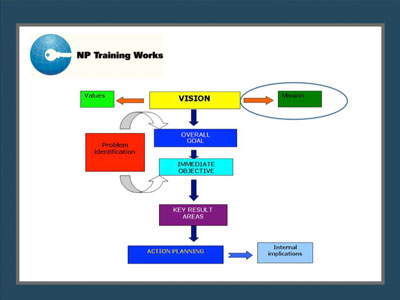 |
Creating and Implementing an Effective Strategic Plan for Your Organization |
1.00 |
Without strategic direction it is hard to get where you want the organization to go. This Webinar offers you a process for reaching your organizational goals. Strategic plans help your organization, or department, set the roadmap to make a significant mission impact. Through this Webinar you will learn a model for completing a Strategic Planning process in your organization. It covers the entire process from planning to defining the strategic framework and then creating a process for implementation activities. You will learn how to create a strategic framework that gives the activities coherence and direction, ensuring that your strategic plan becomes a living, breathing document that is fully utilized in the organization. You will also learn how to involve your board, staff, and other important constituencies in the process to increase your chances of successful implementation. In addition, you will receive leave-behinds that give you practical exercises and instructions to use during your strategic planning process. |
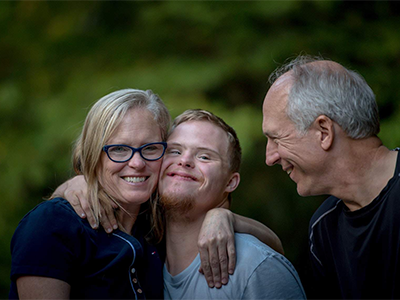 |
Creating an Inclusive Program |
2.00 |
With planning, training, and support, program staff can successfully include many children with special needs. Program staff must develop the skills necessary to assess the environment, materials, equipment, and activities to make the necessary modifications and accommodations so that all children and youth in their programs are successful. During this course, participants will discuss the law regarding inclusion as well as the attitude and reasonable accommodations needed to create an inclusive environment for children and youth with special needs. |
 |
Creating an Inclusive Classroom for Paraprofessionals |
1.25 |
To make our schools emotionally and physically safe places, we must make sure that the needs of all students are being met. We must remember that students with disabilities are like all other students, and exhibit more similarities than differences when compared with peers of the same age. When we provide students with the least restrictive environment, inclusion becomes critical. Paraprofessionals that understand inclusion are better able to provide an environment that includes all students, regardless of their individual barriers. |
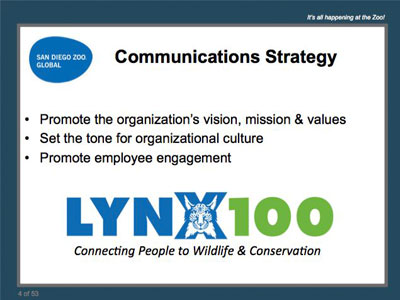 |
Creating a World Famous Employee Communications Strategy |
1.00 |
In recent years, San Diego Zoo Global's Internal Communications programs have been nationally recognized for excellence in outstanding employee communications. During this webinar, you will hear best practices from a seasoned pro at employee communications - covering latest trends, social media, employee forums, electronic newsletters, and creation of a cutting edge intranet for your organization. You will not want to miss this one...
|
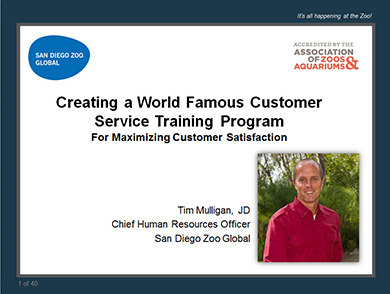 |
Creating a World Famous Customer Service Training Program |
1.00 |
Are you interested in putting together a unique, world class, and cost effective Customer Service Training Program, rather than just purchasing one "off the shelf?" This webinar will walk you through the steps taken by San Diego Zoo Global to create its GRRREAT! Customer Service Training Program - all done in house! |
 |
Creating a World Famous Culture in your Workplace |
1.00 |
This session will give you an overview of how the World Famous San Diego Zoo defines company culture, and what forward thinking innovations they undertook to transform their culture into a World Famous Culture. You will learn a "zooprint" for success on company culture, including several best practices that you can use in your own workplace. |
 |
Creating a Supportive Classroom Community (CDA 3) |
2.00 |
Learn ways to bring out nurturing, caring behaviors in children and youth to create a classroom community where children and youth support each other. Learn how to use non-competitive games to foster acceptance of all children and youth. Identify the strengths and weaknesses for both you and the children and youth in your program, and how to put the strengths to good use creating a sense of acceptance and community. This course is designed to be part of a Child Development Associate (CDA) Credential™ curriculum. It covers CDA Subject Area 3: Supporting Children's Social and Emotional Development and may also be taken as a stand-alone learning event or as part of a broader early childhood education curriculum. |
 |
Creating a Safety Program |
1.75 |
This course covers the elements of a safety program, accident investigation, hazardous communication standard, and new employee orientation for construction detailing site hazards. |
 |
Creating a Safe and Respectful Environment for Our Nation's Children and Youth |
0.75 |
This course will provide you with the knowledge and skills to create safer, more inclusive environments for children. You will learn about the dynamics of bullying, the impact it has on those who are bullied, and strategies for prevention. |
 |
Creating a Quality Summer Program |
2.00 |
CalSAC partnered with the Summer Matters campaign to create our Quality Summer Program training series. Summer months bring unique opportunities for learning outside the traditional school year and walls. High quality summer learning programs change students’ lives for the better with an opportunity to improve their academic achievement and readiness to learn. Developing quality programs requires intentional, ongoing development. Engage in activities that will help identify and strengthen the quality of your summer learning program.
Creating a Quality Summer Program is the first module in the Quality Summer Programming Training series. In this module, participants will learn about the importance of high quality summer learning programs for youth, elements of high-quality summer programs and effective tools to guide programs in their ongoing development of quality programming. |
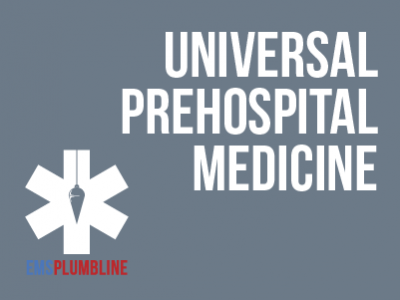 |
COVID-19 Pandemic—EMS Documentation |
1.00 |
Paramedics Mark Philippy and Ben Sensenbach take time in the Spring of 2020 to discuss the documentation concerns that are associated with COVID-19. This in-depth discussion will lead most providers to the conclusion that they are already doing good work and it should continue. This discussion is strong enough to lead the same providers to think slightly differently about what is done during a pandemic period and they may decide to make minor alterations in what the way the document after EMS responses. Final Exam: This multiple-choice exam is designed to test your knowledge of the material you just reviewed. You have three attempts to gain an 80% or higher on this exam. Please take your time and answer each question carefully. |
 |
Cover Letters |
1.00 |
You've found the job you want to apply to and spruced up your resume. Now, all you have to do is submit it. Right? Not so fast! Every resume should have a great cover letter to go with it. |
 |
Course 36: Sharing Information with Parents and Other Professionals |
2.00 |
School-age children work on many important developmental tasks during their out-of-school hours. One of the important responsibilities of OST staff is to help parents stay in touch with how their children are growing and developing during program hours. In addition to parents, professionals who work with children in other settings are often interested in learning how children spend their time when they are not at home or school.
Portfolios are excellent tools for bringing children’s experiences in OST programs to life for parents during planned parent conferences. They are also valuable tools for sharing helpful information about children with other professionals. |
 |
Course 35: Observing Children in School-Age Programs |
2.00 |
Conducting and documenting objective, accurate observations of children in OST programs is an important professional responsibility of OST professionals. Two useful tools for structuring observations are 1) Developmental Checklists and 2) Anecdotal Records. Both tools provide rich information that help staff learn about children’s development. When OST staff conduct regular observations of children’s development and prepare objective documentation of these observations, they are able to discover the uniqueness of each child and provide developmentally appropriate guidance and support for all children in the program. |
 |
Course 34: Creating Community Collaborations |
2.00 |
Across the country, more and more communities are forming community collaborations to address the out-of-school needs of children and youth of all ages. When different segments of the community join together, share ideas, and pool their resources and efforts to create OST initiatives, children and youth benefit. What one organization or program may not be able to accomplish alone, is often achievable when partnerships and collaborations among diverse groups and individuals are formed.
When OST professionals are knowledgeable about what it takes to create and sustain successful collaborations, they can play an important leadership role in creating OST initiatives and programs that will meet the needs of children and youth in their communities now and in the future.
|
 |
Course 33: Youth Development Trends: Focus on Older Youth |
2.00 |
The Center for Early Adolescence at the University of North Carolina and the Search Institute have found that early adolescence is a time of rapid change in youth development and developmental needs. For many children, the characteristic needs of early adolescence begin to emerge as early as age nine, when children are still in elementary school and attending traditional OST programs. OST professionals who understand these emerging needs are better equipped to create successful program experiences with older children in their programs.
The number of quality OST programs for children between five and twelve is steadily growing across the country. At the same time, there is increasing public interest in establishing programs that can also address and support the out-of-school needs of children over age twelve. For many years, communities tried to meet the needs of older youth by a problem-solving approach that focused on helping youth by fixing what was wrong. New trends in youth development take a more positive approach and are focused on working with youth to create positive outcomes.
OST professionals who are knowledgeable about adolescent development and developmental needs and are knowledgeable about youth development research and trends can play important roles in helping their communities design and develop the next level of program services for children over the age of twelve. By learning about ways to support the developmental needs of older youth, OST professionals can join with others to create strategies and programs for continuing to build on the positive experiences younger children have in their OST programs. |
 |
Course 32: Current Trends and Issues in Out-of-School Time Programs |
2.00 |
It is important for OST professionals to understand how the field has developed since its inception and to be knowledgeable about the current status of the OST field. With this knowledge and understanding, it is possible for OST professionals to participate in shaping the field as it grows in the future.
The field of OST is growing and changing as national researchers learn more about what works best in OST programs for a wide range of children and youth, their families, and their communities. Other positive changes are occurring as advocates for OST succeed in creating more public awareness about the need to make quality OST services available to all children and youth across the country. In addition, the OST field is undergoing a metamorphosis as experienced professionals in several different disciplines and fields share and contribute their knowledge, skills, and insights with the goal of creating national models that represent the best possible OST programs.
In this climate of change, OST programs face a number of important issues, revolving around the availability, affordability, and accountability of programs. Many national trends and issues have implications for OST at the state and local level. When OST professionals are well informed about national developments in the field, they can become more effective OST advocates as they design and implement high quality, sustainable programs that are responsive to youth, family, and community needs. |
 |
Course 31: The Six "Ps" of Marketing School-Age Programs |
2.00 |
Effective marketing of OST programs is a systematic process that involves research, analysis, assessment of market trends and needs, short-term and long-term planning, and development of effective strategies to promote OST program services and develop a positive image of the program in the community. It is important for OST leaders to recognize that marketing is a far reaching process that includes, but is not limited to, advertising and publicity. When OST leaders take a comprehensive approach to marketing, their programs and projects have an excellent chance of success. Knowledge and understanding of the marketing process is an invaluable tool for OST leaders as they plan and implement new programs and projects, assess the stability and need for improvement of current programs, develop plans for new or expanded programs, and develop a positive public image of the program and its services. |
 |
Course 30: Creating and Managing Budgets in School-Age Programs |
2.00 |
When program budgets are developed through a careful, step-by-step process, they become valuable planning tools. By using effective budget planning tools and strategies, OST professionals can make realistic projections about the program’s financial stability and design strategies for generating and allocating resources to support the program’s vision and mission. It is important for OST professionals to understand that the budget process is ongoing. It involves linking financial goals to program goals, identifying program priorities, allocating resources effectively, using reliable methods for calculating potential expenses and revenues, monitoring performance against projections made, and making needed changes and adjustments for the future. |
 |
Course 29: Making Plans and Developing Policies |
2.00 |
Planning and policy-making are closely linked to the development of quality OST programs. When OST staff are skilled as planners and policy-makers, they can use these skills to design and implement high quality programs that benefit children, youth, and families. It is essential for OST professionals to recognize that it is important for policies to grow out of a vision of quality and a mission that supports that vision. Therefore, creating a vision for quality, developing a program philosophy, and writing a clear mission statement are the first steps in program planning. It is also important for OST professionals to use a systematic process to develop goals and objectives, set priorities for accomplishing goals and objectives, and develop goal-based action plans that will help the OST program achieve its mission. High quality OST programs are led by professionals who understand how to use effective strategies for creating a continuous cycle of planning and evaluation that supports ongoing program improvement. |
 |
Course 28: Commitment to Quality in School-Age Programs |
2.00 |
School-age child care programs were prevalent during World War II. Many mothers worked outside the home to support the war effort and needed care for their children. When the war ended, school-age child care programs disappeared almost overnight as mother chose to stay at home. School-age programs emerged again in the late 1960’s in response to the vast numbers of mothers across the nation who were re-entering the workforce. National surveys in the 1970’s indicated that at least two-thirds of mothers with school-age children were again employed outside the home. The divorce rate was increasing as well as the number of households headed by a single parent. As a result, many elementary school children spent hours alone from 3:00 to 6:00 when school was out. Clearly, there was a growing need for out-of-school support services for school-age children.
In the 1970’s programs were commonly known as school-age child care or extended day programs. Those establishing programs gave their attention to increasing the availability and affordability of after school services for working parents. By the mid 1970’s, child care advocates also emphasized the importance of providing quality programs. Child care advocates, parents, educators, public policy experts, and representatives from a wide variety of child care and community organizations began a national dialogue to explore and identify the components of quality school-age child care services. Today, national, state, and local organizations are working to educate the public about quality school-age child care services and assist school-age child care professionals achieve quality programming in their communities.
It is essential for OST professionals to be aware of the national and state organizations, research, and practices that focus on the development of quality school-age child care programs. This makes it possible for OST professionals around the country to learn about the dimensions of quality OST/SACC programs and participate in the important process of continuous improvement of their own programs. |
 |
Course 27: Exploring Ethics in School-Age Care: Focus on a Professional Code of Ethics |
2.00 |
According to Frank Loewenberg and Ralph Dolgoff, developing a code of ethics is a significant stage for any profession. “For most American occupational groups the development of a code of ethics coincided, more or less, with the decision to formalize the transformation of the occupation into a profession.” The transformation to a profession allows those working in the profession continuity and heightened sense of purpose. It allows those outside of the profession to realize the integrity and importance of the profession.
When OST/SAC professionals develop, adopt, and adhere to a Code of Ethics, they are guided by underlying principles that represent the values of the OST field. These underlying principles help them determine appropriate courses of action when they face ethical issues as they work with children, parents, colleagues, and community members. |
 |
Course 26: Human Relations Skill Development: Focus on Leadership Styles and Conflict Management |
2.00 |
Research indicates that those in positions of leadership use a variety of different leadership and management styles. A person’s effectiveness as a leader is often directly linked to his or her leadership style. It is important for OST professionals to be aware of the assumptions and characteristics of different leadership styles. Knowledge of different leadership styles can help OST professionals reflect on their own leadership style and assess its effectiveness. It can also help OST professionals take a proactive approach to applying different leadership styles and techniques, depending on the situation.
Leaders also use a variety of different styles when it comes to managing and resolving conflicts. By understanding how to diagnose the causes and dynamics of conflict and understanding the characteristics of different conflict management styles, OST professionals can choose the best conflict management strategy for each situation.
There are a number of skills that enhance the ability of OST professionals to employ different leadership and conflict management styles effectively. When OST professionals are aware of these skills and their own skill levels, they can set priorities for ongoing development of leadership skills. |
 |
Course 25: Focus on Health and Stress Management |
2.00 |
Every day OST professionals dedicate themselves to caring for and nurturing children, youth, and families. Often OST professionals are so dedicated to serving others, they neglect their own needs. When this happens, OST staff can experience stress that causes them to become overwhelmed, exhausted, frustrated, dissatisfied with job responsibilities, and unappreciated. When OST professionals maintain a healthy balanced lifestyle, they are in a much better position to face the challenges of supporting and nurturing children and families with positive energy, enthusiasm, patience, and empathy. By developing self-awareness; linking their personal and professional goals; developing a healthy balanced lifestyle; and identifying and managing stressors effectively, OST staff can create and maintain a positive sense of well-being that allows them to maximize their ability to build positive relationships with children, parents, colleagues, and others. |


























